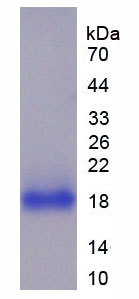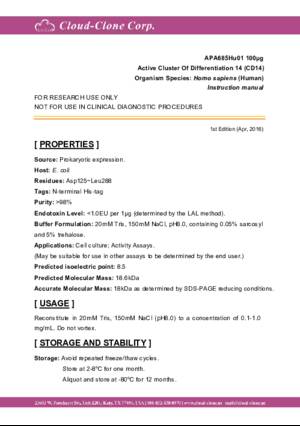Active Cluster Of Differentiation 14 (CD14)
Monocyte differentiation antigen CD14; Myeloid cell-specific leucine-rich glycoprotein
- Product No.APA685Hu01
- Organism SpeciesHomo sapiens (Human) Same name, Different species.
- Buffer Formulation20mM Tris, 150mM NaCl, pH8.0, containing 1mM EDTA, 1mM DTT, 0.01% SKL, 5% Trehalose and Proclin300.
- Traits Freeze-dried powder
- Purity> 97%
- Isoelectric Point8.5
- ApplicationsCell culture; Activity Assays.
- DownloadInstruction Manual
- UOM 10µg50µg 200µg 1mg 5mg
- FOB
US$ 336
US$ 840
US$ 1680
US$ 5040
US$ 12600
For more details, please contact local distributors!
ACTIVITY TEST
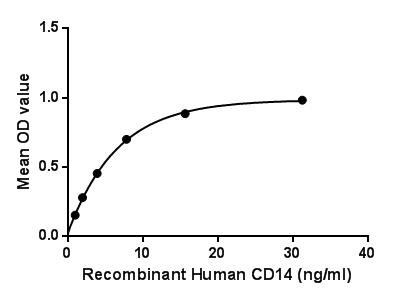
Figure. The binding activity of CD14 with LBP.
Cluster Of Differentiation 14 (CD14), also known as CD14, is a component of the innate immune system. CD14 acts as a co-receptor (along with the Toll-like receptor TLR 4 and MD-2) for the detection of bacterial lipopolysaccharide (LPS). CD14 can bind LPS only in the presence of lipopolysaccharide-binding protein (LBP). Although LPS is considered its main ligand, CD14 also recognizes other pathogen-associated molecular patterns such as lipoteichoic acid. Besides, Lipopolysaccharide Binding Protein (LBP) has been identified as an interactor of CD14, thus a binding ELISA assay was conducted to detect the interaction of recombinant human CD14 and recombinant human LBP. Briefly, CD14 were diluted serially in PBS with 0.01% BSA (pH 7.4). Duplicate samples of 100μL were then transferred to LBP-coated microtiter wells and incubated for 2h at 37℃. Wells were washed with PBST and incubated for 1h with anti-CD14 pAb, then aspirated and washed 3 times. After incubation with HRP labelled secondary antibody, wells were aspirated and washed 3 times. With the addition of substrate solution, wells were incubated 15-25 minutes at 37℃. Finally, add 50µL stop solution to the wells and read at 450nm immediately. The binding activity of CD14 and LBP was shown in Figure 1, and this effect was in a dose dependent manner.
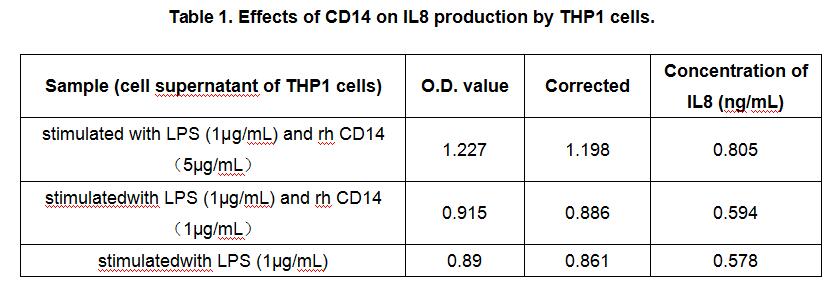
CD14 also can enhance LPS-stimulated IL-8 secretion by THP-1 human acute monocytic leukemia cells. Therefore, THP1 cells were cultured in 24 well plates at a concentration of 106 cells/mL and stimulated by LPS (1μg/mL), then added of different concentrations of recombinant human CD14 (1μg/mL, 5μg/mL). After 24h later, the production of IL8 was determined in the supernatants by cytokine specific ELISA.
Result: When the concentration of CD14 was 5μg/mL, the secretion LPS-stimulated IL-8 can be significantly increased.
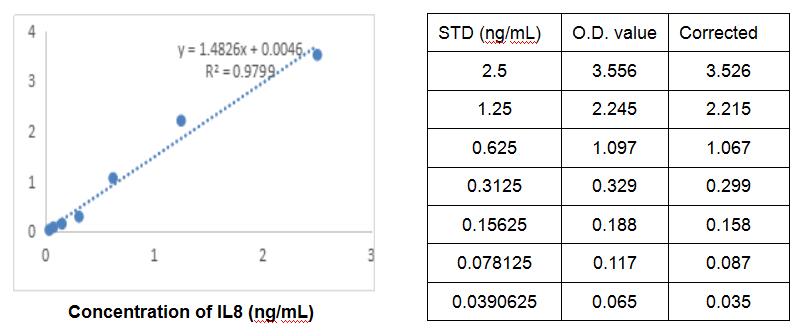
The standard curve was demonstrated as follows.
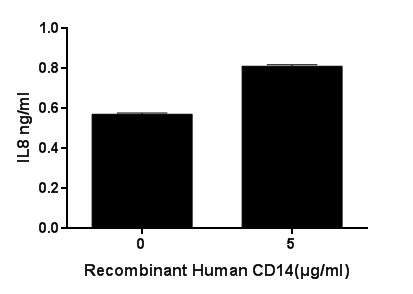
Figure. Effects of CD14 on IL8 production by THP1 cells.
USAGE
Reconstitute in 20mM Tris, 150mM NaCl (pH8.0) to a concentration of 0.1-1.0 mg/mL. Do not vortex.
STORAGE
Avoid repeated freeze/thaw cycles. Store at 2-8°C for one month. Aliquot and store at -80°C for 12 months.
STABILITY
The thermal stability is described by the loss rate. The loss rate was determined by accelerated thermal degradation test, that is, incubate the protein at 37°C for 48h, and no obvious degradation and precipitation were observed. The loss rate is less than 5% within the expiration date under appropriate storage condition.
GIVEAWAYS
INCREMENT SERVICES
-
 BCA Protein Quantification Kit
BCA Protein Quantification Kit
-
 Molecular Mass Marker for Protein
Molecular Mass Marker for Protein
-
 Monoclonal Antibody Customized Service
Monoclonal Antibody Customized Service
-
 Polyclonal Antibody Customized Service
Polyclonal Antibody Customized Service
-
 Protein Activity Test Experiment Service
Protein Activity Test Experiment Service
-
 Electrophoretic Mobility Shift Assay (EMSA) Experiment Service
Electrophoretic Mobility Shift Assay (EMSA) Experiment Service
-
 Buffer
Buffer
-
 Lentivirus Packaging Experiment Service
Lentivirus Packaging Experiment Service
-
 Adenovirus Packaging Experiment Service
Adenovirus Packaging Experiment Service
-
 Real Time PCR Experimental Service
Real Time PCR Experimental Service
-
 Spike RBD Protein (S-RBD)
Spike RBD Protein (S-RBD)
-
 Protein G
Protein G
-
 Protein A
Protein A
| Magazine | Citations |
| Journal of Pharmacology and Experimental Therapeutics | Successful Treatment of Acute Lung Injury with Pitavastatin in Septic Mice: Potential Role of Glucocorticoid Receptor Expression in Alveolar Macrophages Aspet: 171462 |
| Tumour Biol | Elevated serum soluble CD15 levels in chronic HBV infection are significantly associated with HBV-related hepatocellular carcinoma PubMed: 26643894 |
| Free Patents online | RHEUMATOID ARTHRITIS RELATED BIOMARKER 20170350884 |
| Intensive Care Research | Evaluating the Roles of sCD14 and sCD14-ST in Diagnosing COPD and Predicting an Acute Exacerbation of COPD |



